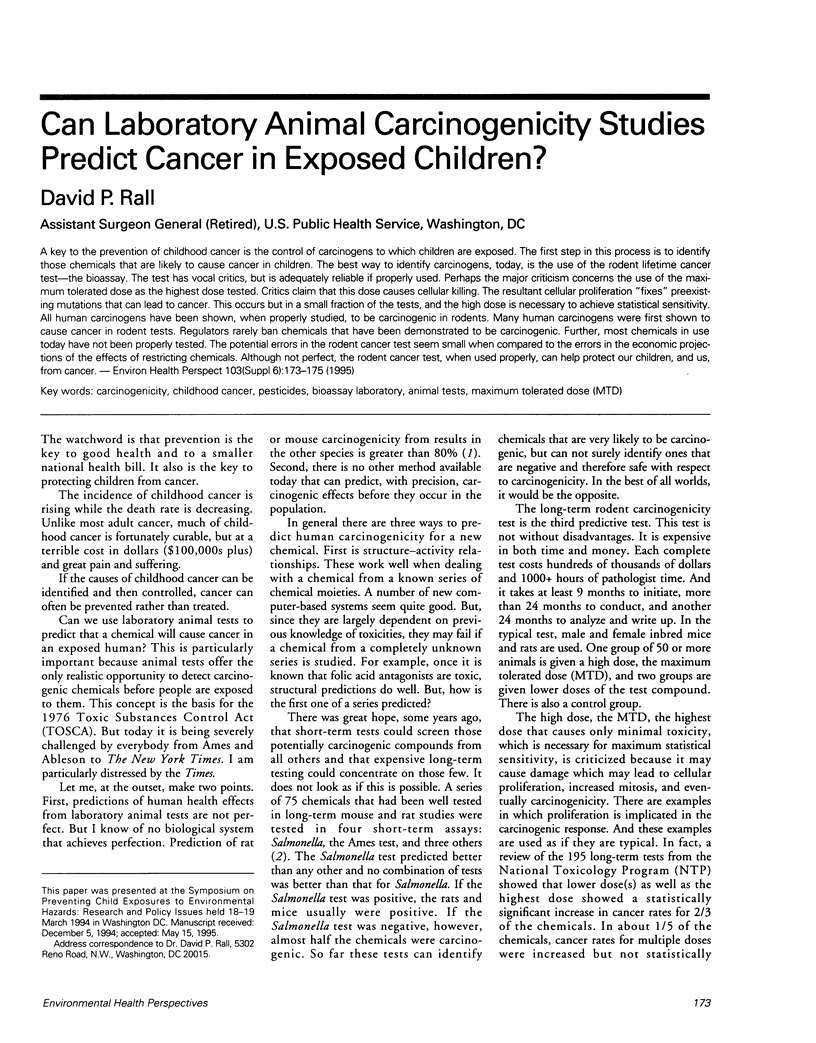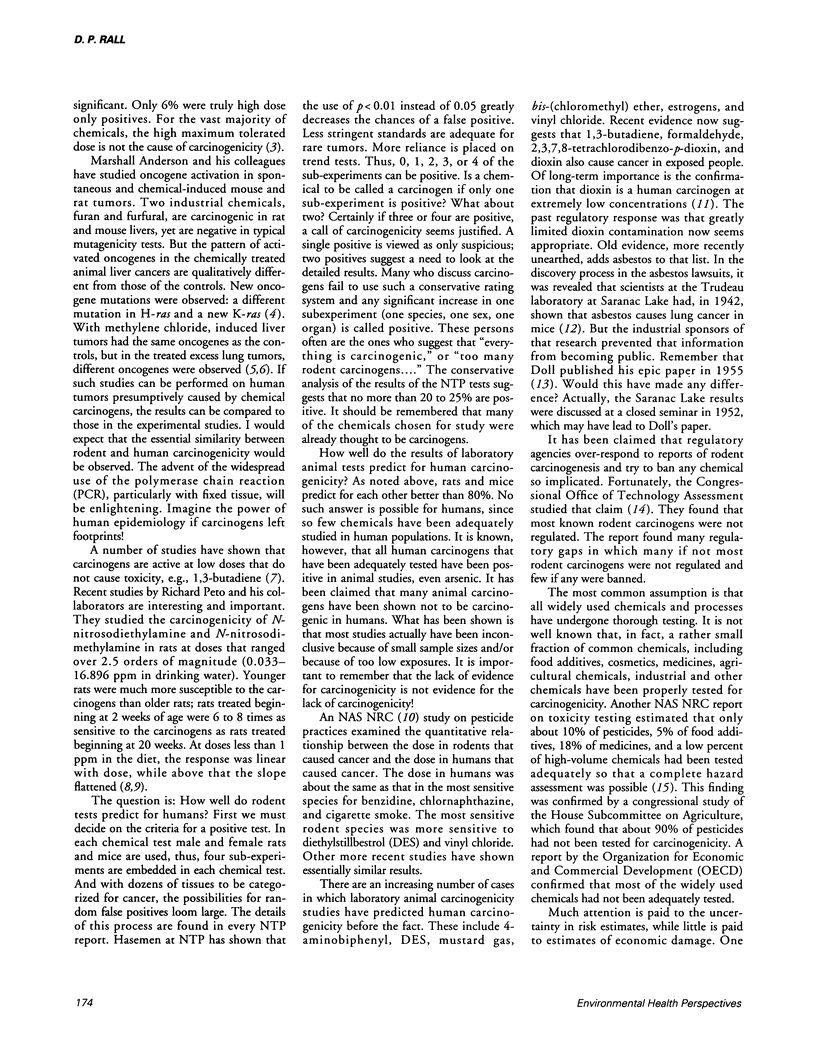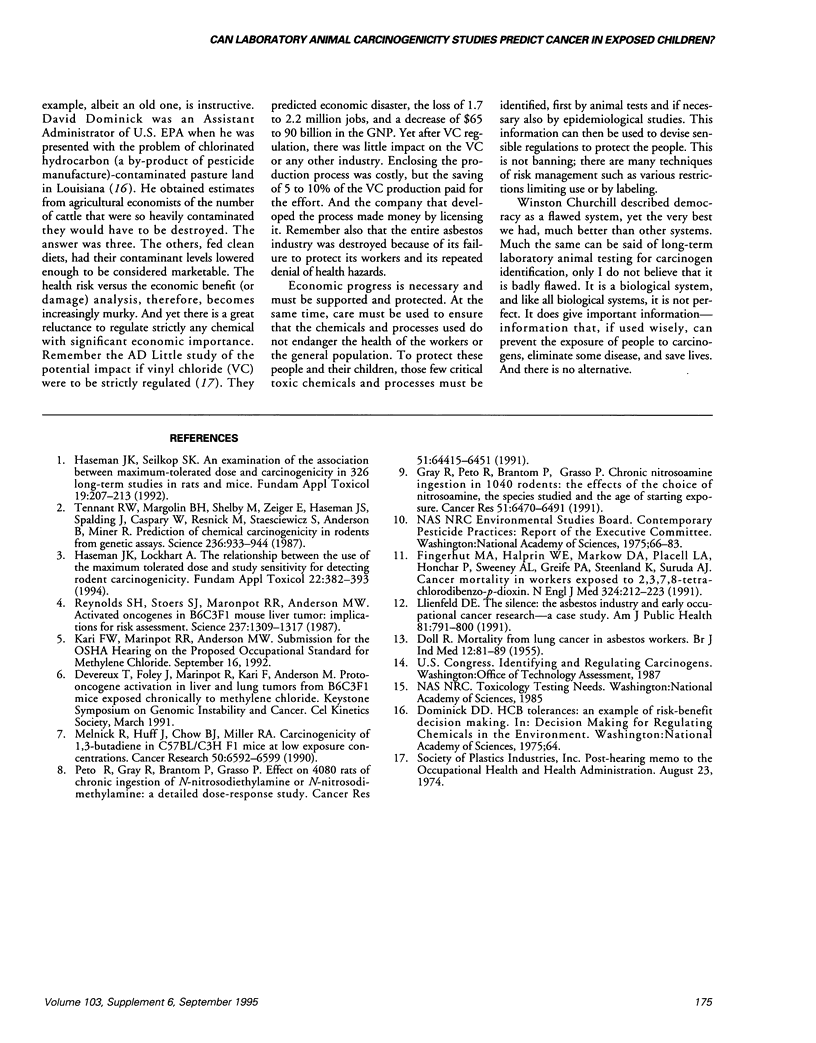Abstract
A key to the prevention of childhood cancer is the control of carcinogens to which children are exposed. The first step in this process is to identify those chemicals that are likely to cause cancer in children. The best way to identify carcinogens, today, is the use of the rodent lifetime cancer test--the bioassay. The test has vocal critics, but is adequately reliable if properly used. Perhaps the major criticism concerns the use of the maximum tolerated dose as the highest dose tested. Critics claim that this dose causes cellular killing. The resultant cellular proliferation "fixes" preexisting mutations that can lead to cancer. This occurs but in a small fraction of the tests, and the high dose is necessary to achieve statistical sensitivity. All human carcinogens have been shown, when properly studied, to be carcinogenic in rodents. Many human carcinogens were first shown to cause cancer in rodent tests. Regulators rarely ban chemicals that have been demonstrated to be carcinogenic. Further, most chemicals in use today have not been properly tested. The potential errors in the rodent cancer test seem small when compared to the errors in the economic projections of the effects of restricting chemicals. Although not perfect, the rodent cancer test, when used properly, can help protect our children, and us, from cancer.
Full text
PDF


Selected References
These references are in PubMed. This may not be the complete list of references from this article.
- DOLL R. Mortality from lung cancer in asbestos workers. Br J Ind Med. 1955 Apr;12(2):81–86. doi: 10.1136/oem.12.2.81. [DOI] [PMC free article] [PubMed] [Google Scholar]
- Fingerhut M. A., Halperin W. E., Marlow D. A., Piacitelli L. A., Honchar P. A., Sweeney M. H., Greife A. L., Dill P. A., Steenland K., Suruda A. J. Cancer mortality in workers exposed to 2,3,7,8-tetrachlorodibenzo-p-dioxin. N Engl J Med. 1991 Jan 24;324(4):212–218. doi: 10.1056/NEJM199101243240402. [DOI] [PubMed] [Google Scholar]
- Gray R., Peto R., Brantom P., Grasso P. Chronic nitrosamine ingestion in 1040 rodents: the effect of the choice of nitrosamine, the species studied, and the age of starting exposure. Cancer Res. 1991 Dec 1;51(23 Pt 2):6470–6491. [PubMed] [Google Scholar]
- Haseman J. K., Lockhart A. The relationship between use of the maximum tolerated dose and study sensitivity for detecting rodent carcinogenicity. Fundam Appl Toxicol. 1994 Apr;22(3):382–391. doi: 10.1006/faat.1994.1043. [DOI] [PubMed] [Google Scholar]
- Haseman J. K., Seilkop S. K. An examination of the association between maximum-tolerated dose and carcinogenicity in 326 long-term studies in rats and mice. Fundam Appl Toxicol. 1992 Aug;19(2):207–213. doi: 10.1016/0272-0590(92)90153-9. [DOI] [PubMed] [Google Scholar]
- Lilienfeld D. E. The silence: the asbestos industry and early occupational cancer research--a case study. Am J Public Health. 1991 Jun;81(6):791–800. doi: 10.2105/ajph.81.6.791. [DOI] [PMC free article] [PubMed] [Google Scholar]
- Melnick R. L., Huff J., Chou B. J., Miller R. A. Carcinogenicity of 1,3-butadiene in C57BL/6 x C3H F1 mice at low exposure concentrations. Cancer Res. 1990 Oct 15;50(20):6592–6599. [PubMed] [Google Scholar]
- Peto R., Gray R., Brantom P., Grasso P. Effects on 4080 rats of chronic ingestion of N-nitrosodiethylamine or N-nitrosodimethylamine: a detailed dose-response study. Cancer Res. 1991 Dec 1;51(23 Pt 2):6415–6451. [PubMed] [Google Scholar]
- Reynolds S. H., Stowers S. J., Patterson R. M., Maronpot R. R., Aaronson S. A., Anderson M. W. Activated oncogenes in B6C3F1 mouse liver tumors: implications for risk assessment. Science. 1987 Sep 11;237(4820):1309–1316. doi: 10.1126/science.3629242. [DOI] [PubMed] [Google Scholar]
- Tennant R. W., Margolin B. H., Shelby M. D., Zeiger E., Haseman J. K., Spalding J., Caspary W., Resnick M., Stasiewicz S., Anderson B. Prediction of chemical carcinogenicity in rodents from in vitro genetic toxicity assays. Science. 1987 May 22;236(4804):933–941. doi: 10.1126/science.3554512. [DOI] [PubMed] [Google Scholar]


